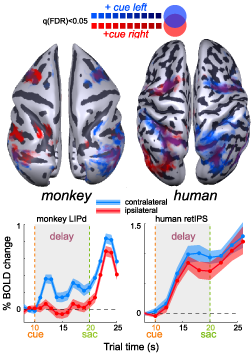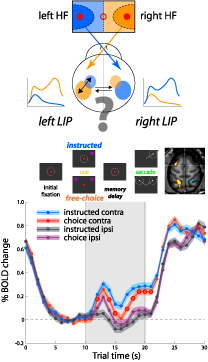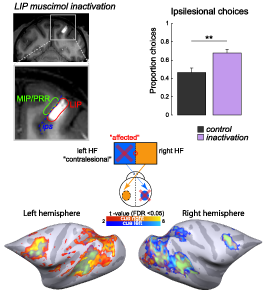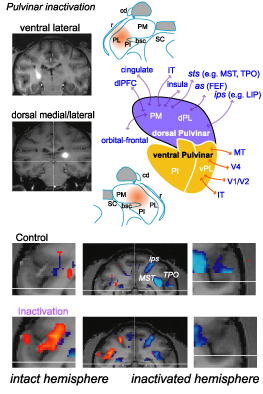Research
Our research aims to understand the neural basis of cognitive functions such as spatial awareness and decision making: the ability to perceive and to act adequately in response to multiple external sensory events, exhibiting a flexible behavior in face of several alternatives. We are utilizing neurophysiological recordings (neuronal firing and local field potential) in behaving macaque monkeys, functional imaging (fMRI) in monkeys and humans, and reversible perturbations (inactivation and stimulation) of specific brain regions to study these functions on the local (neuronal) and global (network) levels. Our current work is focusing on intra-areal, interhemispheric, and pulvinar-cortical interactions and communication during visuomotor decision making and response selection, a monkey model of spatial neglect and decision making deficits, and monkey-human comparison of these functions.
Human-monkey comparison of visuomotor processing

Most of the current knowledge about the mechanisms underlying visuospatial and visuomotor processing is derived from electrophysiological recordings in macaques, and more recently from functional imaging experiments in humans. Due to an important need to integrate results from both types of studies, it is tempting to simply equate electrophysiology and imaging data. However, the relationship between human imaging and monkey electrophysiological studies is often not clear because of differences between the two species and the complicated relationship between electrophysiological and fMRI signals. To facilitate the integration of human and monkey data, and to investigate inter-species similarities and differences from the evolutionary perspective, we study both species by means of the same method, fMRI. In order to link fMRI activations to underlying neuronal activity we perform analogous experiments using electrophysiological recordings in monkeys. In particular, we are interested in comparing cerebral asymmetry and lateralization patterns for spatial and effector representations.
On the methodological level, we apply the time-resolved event-related approach to both monkey and human imaging. This allows investigating dynamic brain activity originating from specific task epochs, for example cognitive decision and planning signals that bridge sensory input and motor output events in the delay response paradigms.
Intra- and interhemispheric interactions during decision-making

The ability to explore and flexibly decide between multiple response options is an important and highly developed attribute of primate behavior. A central question towards understanding the neural mechanisms of goal-directed behavior is how the distributed activity in multiple brain areas is integrated within and across the two hemispheres. For example, the circuitry underlying spatial decisions encompasses a bihemispheric network, in which each hemisphere represents predominantly contralateral response options. Thus, when a primate is faced with multiple response options in opposite visual hemifields, how does brain activity in the two hemispheres converge to a specific decision? Existing models postulate inter-hemispheric competition and/or cooperation, but how the signals from the two hemispheres interact is not known, and direct neuronal evidence for interhemispheric competition is scarce. We are addressing these questions using event-related fMRI and bi-hemispheric neuronal recording during free- and reward-based choice tasks.
Cortical and thalamic mechanisms of spatial awareness and neglect

The intact visual awareness of space around us is an emergent property of activity in the two brain hemispheres. Following a damage to certain regions in one hemisphere, the perception and action in the contralesional hemispace are impaired, leading to spatial neglect syndrome. The dominant model of spatial neglect, the interhemispheric opposition, or rivalry theory, postulates mutually suppressive interactions between two hemispheres that are in equilibrium in the normal state, and whose balance is disturbed following the lesion. This theory is corroborated by stimulation studies showing that inhibition of the healthy hemisphere may alleviate neglect symptoms. However a direct neuronal evidence for the proposed interhemispheric suppression is still largely missing. The study of basic neglect mechanisms in human patients is hindered by large and variable lesions, lack of pre-lesion "baseline" data, and medical considerations.
Using local reversible pharmacological inactivation of MRI-targeted brain areas, we are studying the basic mechanisms of spatial disorders and recovery in a monkey model. Since pharmacological agent action is limited to several hours, inactivation experiments in combination with fMRI or electrophysiological recordings can be performed repeatedly in the same subject, both in normal and lesioned states. Using this technique, we are hoping to gain insight into the dynamic interactions between areas within each hemisphere and between hemispheres that underlie spatial neglect and recovery.
Role of thalamo-cortical interactions in cortical communication and visuomotor coordination

The thalamic pulvinar has greatly enlarged during primate evolution in parallel with cortical areas subserving visuomotor functions. Key visuomotor cortical regions to which the pulvinar reciprocally connects are the posterior parietal and the frontal cortices. Although communication between frontal and parietal areas can be mediated by direct cortico-cortical connections, recent theories have highlighted a possible contribution of the pulvinar to cortical communication. This notion is supported by our recent studies showing abnormal BOLD signal in parieto-frontal areas and sensorimotor and movement decision deficits as a consequence of reversible pulvinar inactivation. By means of combined reversible inactivation and electrophysiological and fMRI recordings we are investigating the contribution of the pulvinar to communication in frontoparietal circuits.
